| Srl | Item |
| 1 |
ID:
132511
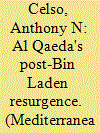

|
|
|
|
|
| Publication |
2014.
|
| Summary/Abstract |
The Barack Obama administration's May 2013 assessment of al Qaeda's weakness and fracturing in the post-bin Laden era has been greeted with indignation by both liberals and conservatives. They believe al Qaeda is stronger than ever in the wake of the Arab Spring. These critics, however, misunderstand the network's dysfunctional direction. Al Qaeda's "resurgence" is likely to lead to its failure. The argument proceeds on four levels: (1) the dramatic growth of the al Qaeda network masks its internal weakness and organizational splintering; (2) the Arab Spring has led to a burst of al Qaeda activism that is likely to undermine its jihadist cause; (3) al Qaeda's fragmentation and its multiple trajectories in the post-9/ 11 era violate bin Laden's original intent and are beyond al Qaeda Central's direction; and (4) the dysfunctional nature of al Qaeda's ideology and its excessive reliance on takfiri violence is paradoxically a source of both persistence and failure.
|
|
|
|
|
|
|
|
|
|
|
|
|
|
|
|
| 2 |
ID:
075048
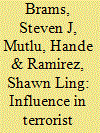

|
|
|
|
|
| Publication |
2006.
|
| Summary/Abstract |
A methodology for converting terrorist networks from undirected graphs to simplified directed graphs (or digraphs), and mapping the flow of influence in them, is described. It is based on an "influence assumption"-that important persons with more links influence less important persons with fewer links. This methodology, which was previously used to analyze the structure of influence relationships in Communist-bloc countries and the international system, is illustrated by its application to two terrorist networks constructed after 9/11. In the second more complex network, the hierarchy sheds light on the leadership and likely terrorist cells embedded in the network. Refined data and alternative assumptions about influence could provide additional insights into the structure of terrorist networks.
|
|
|
|
|
|
|
|
|
|
|
|
|
|
|
|
| 3 |
ID:
110005
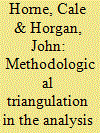

|
|
|
|
|
| Publication |
2012.
|
| Summary/Abstract |
The conceptualization of terrorist groups as networks is increasingly common to terrorism studies, although methods of analysis vary widely. Contrary to common understandings, the integration of computational and qualitative methods is possible even with limited (small-n) data. The triangulation of different methods can produce insights overlooked by the use of any single method and validate findings across methods. This article demonstrates some of the possibilities for integrating qualitative and quantitative methods for network analysis using Raffaello Pantucci's recent article, "The Tottenham Ayatollah and The Hook-Handed Cleric: An Examination of All Their Jihadi Children."
|
|
|
|
|
|
|
|
|
|
|
|
|
|
|
|
| 4 |
ID:
172819
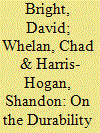

|
|
|
|
|
| Summary/Abstract |
This article conducts a social network analysis (SNA) on discrete groups of Australian-based jihadists across three time periods and then compares these groups to an aggregated network. The aim of this analysis is to potentially reveal hidden connections between seemingly separate groups that could facilitate the flow of information and resources. Results reveal the presence of a number of key actors who appear to connect groups across different geographic locations and time periods. By utilizing SNA to identify the presence of these critical individuals, this case study aims to contribute to our overall understanding regarding how terrorist networks manage to endure, evolve, and adapt over time.
|
|
|
|
|
|
|
|
|
|
|
|
|
|
|
|
| 5 |
ID:
094730
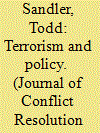

|
|
|
|
|
| Publication |
2010.
|
| Summary/Abstract |
This article sets the stage for the special issue by indicating the current focus in the literature on applying analytical tools to enlighten policy makers in the practice of counterterrorism in the post-9/11 era. In particular, the article briefly indicates the main areas of recent work. The article also introduces some key concepts. Next, the article highlights the methodology and main contributions of each of the seven articles of the special issue. The novelty and policy insights of each article are emphasized.
|
|
|
|
|
|
|
|
|
|
|
|
|
|
|
|
| 6 |
ID:
092468
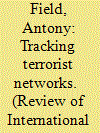

|
|
|
|
|
| Publication |
2009.
|
| Summary/Abstract |
The 7/7 terrorist attacks demonstrated that there were some clear deficiencies with the organisation of the United Kingdom's counter-terrorism intelligence community. In the aftermath of the attacks, there were moves to develop a more robust 'counter-terrorism network' in the United Kingdom that would facilitate better communication and intelligence sharing. While recent developments are to be welcomed, the reforms have not addressed some of the fundamental cultural, institutional and technological issues at the heart of the problem. The creation of an effective counter-terrorism network demands that information flows more freely through the intelligence community and that institutional boundaries are broken down. Until these obstacles have been overcome, the new counter-terrorism network will continue to be hampered by the same old problems of intelligence sharing.
|
|
|
|
|
|
|
|
|
|
|
|
|
|
|
|
| 7 |
ID:
131780
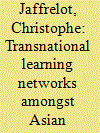

|
|
|
|
|
| Publication |
2014.
|
| Summary/Abstract |
The students of transnational flows, including James Rosenau,1 have pertinently highlighted the growing assertion of 'sovereign free actors' at the expense of 'sovereign bound actors' in what they call postinternational politics.2 Dealing mostly with the end of the Cold War era, they have tended to focus on the increasingly important role of not only the multinational firms but also of the financial companies on newly globalized markets, and not only law-abiding but also illicit traffickers (of drugs, arms etc.) which have prospered along with increasingly more effective means of communication.
They have almost completely ignored the transnationalization of religions, except from the point of view of fundamentalisms and related terrorist networks. Sociologists have paid more attention to this development.3 But these studies, which have mostly focused on the impact of migrations,4 have tended to under estimate the resilience of state boundaries5 and have often neglected the circulation of ideas, especially from the point of view of the learning networks-the very object of this Special Issue which concentrates on one particular creed: Islam.
|
|
|
|
|
|
|
|
|
|
|
|
|
|
|
|